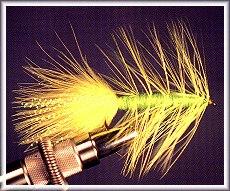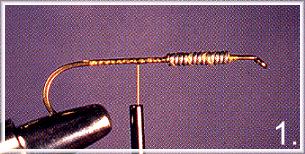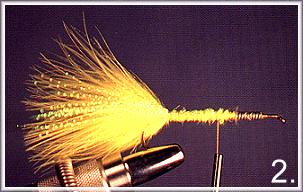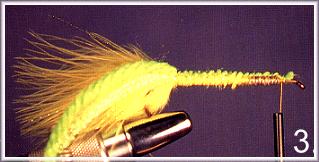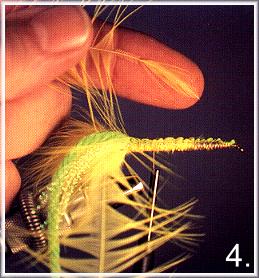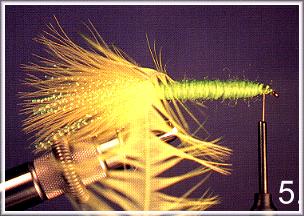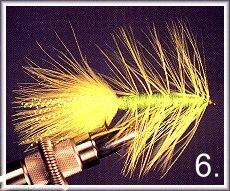|
Bass Woolly Bugger
The Woolly Bugger is an ideal underwater fly for bass because it simulates
many prey items that bass like: baitfish, crayfish, dragonfly nymphs, leeches
or other quarry. Also, the hackle and marabou creates the illusion of bulk
and lifelike movement, but without the bulk. These materials collapse against
the hook shank when cast, offereing minimal air resistance and allowing for
a smooth, streamline cast.
Tying Tips
Some tie the Woolly Bugger without a lead wire underbody, theorizing that
the fly swims more smoothly underwater and reacts better to the anglers' fly
line manipulations. The advantage to lead weighting is that the fly sinks
better, and if you weight just the front of the fly as in the photos, the fly
exhibits an up-abd-down jigging effect on the retrieve, which attracts fish.
The Woolly Bomber includes weighted eyes on the front of the fly. (Be
sure to tie the eyes on top of the shank so the fly will flip over on the
retrieve, helping to avoid snags.) There is no "right" or "wrong" way
to tie this fly. Also, the marabou "shrinks" when underwater, so tie in
about twice the amount you want the sunken fly to display. However,
too much marabou inhibits the sink rate of the fly.
Some good color combinations include (body/hackle):
black / grizzly; black / olive; black / fluorescent blue with blue
Flashabou in tail; brown / grizzly; brown / olive; brown / brown; all
black, white or chartreuse.
Variations
The origins of the Woolly Bugger lie with the Woolly Worm. In
The Practical Fly Fisherman, 1953 A.J. McClane
wrote that the Woolly Worm ". . .made its reputation as an Ozark
bass fly back in the 1920s. Actually this pattern was first described
by Izaak Walton back in 1653 and has three centuries of recommendation
to its credit."
If we look into one of the first written words on fly fishing, in Treatise
On Fysshynge Wiyh An Angle 1496, Juliana Bernes wrote, "The
wasp fly: the bodyof back wool and wound about with yellow thread, the
wings of the buzzard." If we could view what Dame Bernes tied, we might
see a prototype black Woolly worm with yellow thread rib and black
palmered hackle. If not exactly what we use today, a black fly with
loose flowing black hackle is an excellent prescription for a fish-catching
fly, made all the better for the addition of a marabou tail.
Tie a few of these in various sizes, some with and some without a weedguard.
To some, add a bit of Fashabou to the tail, to impart bright quick flashes that
bass can see in turbid water. ~ Deke Meyer
Materials List:
Hook: 2X-long, 3X-long or 4X-long shank, heavy wire,
size 1/0 - 10.
Thread: Yellow 6/0 or 8/0.
Tail: Marabou; Flashabou or Crystal Flash optional.
Body: Yarn, chenille or dubbing.
Hackle: Dyed wide saddle or neck hackle.
Eyes: : Optional, weighted barbell eyes.
Weedguard: Optional, still monofilament, diameter
matches hook diameter.
|

